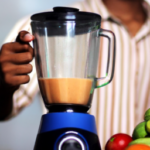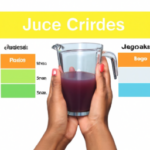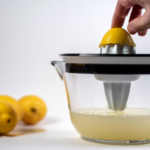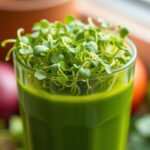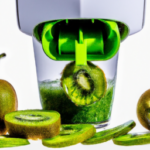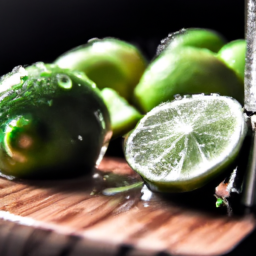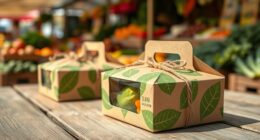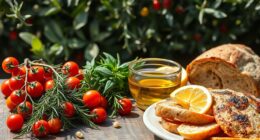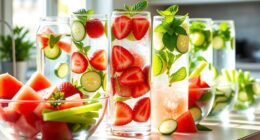I used to believe that juicing was only for those with expensive juicers and lots of extra cash. But my perspective shifted when I discovered how to juice fruit without a juicer. This technique is simple, accessible to anyone with the right tools and fruits, and the benefits are clear.
Juicing allows you to consume a concentrated dose of vitamins, minerals, and antioxidants that are easily absorbed by your body. It’s a quick and convenient way to boost your immune system, improve digestion, and increase energy levels. Plus, it’s a tasty way to incorporate more fruits into your diet.
In this article, I will share my personal experience and tips on how to juice fruit without a juicer, so you too can reap the benefits of this nutrient-packed beverage.
Key Takeaways
- Blending techniques are essential in making fruit juice without a juicer.
- Using a fine mesh strainer or cheesecloth is important to ensure that no pulp or seeds get through.
- Fresh, ripe fruits are easier to extract juice from and contain more nutrients.
- Mixing different fruits can create a balanced and tasty blend that satisfies taste buds and provides essential nutrients.
The Benefits of Juicing
You’re going to love the benefits of juicing, like getting more vitamins and minerals in your diet while also boosting your energy levels. Juicing is a delicious and convenient way to consume a variety of fruits and vegetables that you might not normally eat or enjoy. It’s important to note that while juicing does remove some of the fiber from the produce, it still provides a concentrated source of nutrients that can be easily absorbed by the body.
The health benefits of juicing are numerous. For example, fruits and vegetables are rich in antioxidants, which can help protect the body against harmful free radicals. Additionally, they contain vitamins and minerals that are essential for maintaining good health, including vitamin C, vitamin A, potassium, and folate. Juicing can also be a great way to increase your intake of phytochemicals, which are plant compounds that have been shown to have anti-inflammatory and anti-cancer properties.
With all of these benefits, it’s no wonder that juicing has become such a popular trend in the wellness community.
Now, let’s talk about the tools you’ll need to get started.
Tools You Will Need
To juice fruits without a juicer, you’ll need a few key tools.
First, a blender is essential for breaking down the fruit into a smooth consistency.
Secondly, a strainer will help remove any excess pulp or seeds from the juice.
Finally, a cheesecloth can be used to further strain the juice and remove any remaining solids.
With these tools, you can easily make fresh and nutritious juice at home.
Blender
Blend your favorite fruits in a blender to create a refreshing and satisfying drink that’ll leave you feeling energized and happy. Blending techniques are essential in making fruit juice without a juicer.
When using a blender, it’s important to cut your fruits into small pieces to ensure that they blend well and to prevent clogging. For thicker fruits like bananas and avocados, it’s advisable to add some water to the blender to make the blending process easier.
Alternative methods of blending include using a hand blender or a food processor. A hand blender is a convenient option because it’s easy to use and can be cleaned quickly. On the other hand, a food processor is ideal for fibrous fruits like pineapples and apples because it can break down the fibers and produce a smoother juice.
Once you’ve blended your fruits to a smooth consistency, the next step is to strain the juice using a strainer. By straining the juice, you’ll be able to remove any pulp or seeds that may be present in the juice. This will ensure that your fruit juice is smooth and easy to drink.
Strainer
When using a strainer, simply pour the blended fruit mixture into it to catch any unwanted bits and pieces. This process is quite simple, and all you need is a colander or strainer and a bowl to catch the juice. Here are some tips to help make the process easier:
- Use a fine mesh strainer to ensure that no pulp or seeds get through.
- After pouring the mixture into the strainer, use a spoon or spatula to press down gently on the pulp to extract as much juice as possible.
- For even smoother juice, consider using a nut milk bag. Simply pour the blended mixture into the bag and squeeze out the juice.
While using a strainer is a quick and easy way to juice fruit without a juicer, some people prefer an even smoother juice.
In the next section, we’ll discuss using cheesecloth to achieve this.
Cheesecloth
Cheesecloth is the ultimate secret weapon for achieving an unbelievably smooth and velvety texture in your homemade drinks, making it a game-changer for any true juice enthusiast.
Using cheesecloth to strain your fruit juice is a simple and effective alternative to using a juicer. Simply place a layer of cheesecloth over a large bowl, pour the blended fruit mixture onto the cheesecloth, and gather the corners of the cloth together. Squeeze the juice out of the cloth, and discard any leftover pulp.
When using cheesecloth, there are a few tips and tricks to keep in mind. It’s important to use a fine-mesh cheesecloth to ensure that all the pulp is removed from the juice. Additionally, be sure to squeeze the cheesecloth gently, taking care not to press too hard and force any pulp through the cloth.
If you don’t have cheesecloth on hand, there are alternative straining methods you can use, such as a nut milk bag or a fine mesh strainer.
Choosing the right fruits is also important for achieving a tasty and healthy homemade juice.
Choosing the Right Fruits
When I’m choosing fruits to juice, I always opt for fresh, ripe fruits. These fruits are not only easier to extract juice from, but they also contain more nutrients.
I also consider combinations of fruits to create unique and flavorful blends. However, it’s important to watch out for seeds and pits that can be harmful if consumed.
Opt for Fresh, Ripe Fruits
For the best results, I always opt for fresh, ripe fruits when juicing without a juicer. Choosing the right ripeness is crucial because it affects both the taste and the nutritional value of the juice.
Overripe fruits may be easier to juice, but they tend to be mushy and may not have the same flavor or nutrient content as their fresher counterparts. On the other hand, unripe fruits may be harder to juice and may have a sour taste that may not be pleasing to the palate.
To ensure that I’m using the freshest and ripest fruits for my juice, I always inspect them carefully before purchasing. I look for fruits that are firm, plump, and have a bright color. I avoid fruits that are too soft or have bruises or blemishes. I also pay attention to the smell of the fruit because a sweet, fragrant smell is usually a sign of ripeness.
By choosing fresh, ripe fruits, I can produce a juice that’s flavorful and packed with nutrients.
When considering combinations for my juice, I always keep in mind the flavors and nutritional value of each fruit. By mixing different fruits, I can create a balanced and tasty blend that satisfies my taste buds and provides the nutrients that I need.
Consider Combinations
To make sure you’re getting the most out of your homemade juice, think about mixing different fruits together to create a balanced and delicious blend that’ll satisfy your taste buds and provide essential nutrients. Mixing fruits can also help you avoid getting bored with the same flavors every day.
Here are some flavorful combinations that you can try:
- Strawberry, banana, and orange
- Pineapple, mango, and peach
- Apple, carrot, and ginger
- Watermelon, cucumber, and mint
- Blueberry, raspberry, and blackberry
These combinations not only taste great, but they also provide a variety of vitamins, minerals, and antioxidants. Experiment with different fruits and find your favorite flavor combination.
When mixing fruits, it’s important to keep in mind that some fruits may have seeds or pits that can be difficult to juice.
This leads us to the next section about watching out for seeds and pits.
Watch Out for Seeds and Pits
Be mindful of seeds and pits in your fruit when creating a delicious and nutritious juice blend. While it’s easy to overlook, these tiny bits can pose choking hazards if not removed prior to juicing. Seeds and pits can also make the texture of your juice gritty and unpleasant.
To avoid any potential hazards and ensure a smooth juice, take the time to remove any seeds or pits from your fruit. This can be done by simply cutting the fruit in half and using a spoon to scoop out any seeds or pits.
Additionally, some fruits may have tough skins that can be difficult to juice, such as citrus fruits. To remove these skins, use a sharp knife to carefully cut away the outer layer before juicing. By taking these precautions, you can enjoy a safe and tasty juice blend without any unpleasant surprises.
Now that you know how to watch out for seeds and pits in your fruit, it’s time to move on to the preparation stage of creating a homemade juice blend.
Preparation
First, grab a sharp knife and a cutting board to begin preparing your fruit for juicing without a juicer. Start by washing your fruit thoroughly to remove any dirt or residue.
Next, cut the fruit into small pieces to make it easier to blend. Place the fruit pieces into a blender or food processor and add a little bit of water to help with the blending process.
Once you’ve blended the fruit, you’ll need to strain it to remove any pulp or seeds. This can be done using a fine-mesh sieve or cheesecloth. Simply pour the blended fruit mixture through the sieve or cheesecloth and into a container. The resulting liquid will be smooth and free of any unwanted bits.
Now, you’re ready to enjoy your freshly squeezed fruit juice!
Straining
Now that I’ve prepared my fruits for juicing, it’s time to move on to straining.
There are a few ways to strain your juice without a juicer. I’ve found that using a strainer, cheesecloth, or pressing the pulp are all effective methods.
Using a strainer is the easiest and quickest option. However, if you want a smoother consistency, using cheesecloth or pressing the pulp may be necessary.
Use a Strainer
To strain your fruit juice without a juicer, all you need is a fine-mesh strainer and a bit of elbow grease – as the saying goes, no pain, no gain! If you don’t have a fine-mesh strainer, don’t worry, there are other strainer alternatives available.
You can use a cheesecloth, coffee filter, or even a clean kitchen towel. Whatever strainer you choose, make sure it’s clean and free of any debris before you start straining.
When using a strainer, it’s important to use proper straining techniques to get the most juice out of your fruit. Start by cutting your fruit into small pieces and mashing them with a fork or potato masher. This will help release the juice from the fruit.
Then, place the strainer over a bowl or measuring cup and pour the mashed fruit into the strainer. Use a spoon or spatula to press down on the fruit and extract as much juice as possible. Once you’ve strained all the juice you can, you can move on to the next step of using cheesecloth to strain your fruit juice.
Use Cheesecloth
Don’t forget to use a clean cheesecloth to strain your homemade juice, as it’s a great alternative to a juicer. Cheesecloth alternatives are affordable, easy to find, and reusable. Here are some tips to get the most out of your cheesecloth:
-
Fold the cheesecloth: Fold the cheesecloth into multiple layers to create a finer strainer. This will prevent any pulp or seeds from getting into your juice.
-
Secure the cheesecloth: Use a rubber band or string to secure the cheesecloth over a bowl or pitcher. This will ensure that the cheesecloth stays in place while you pour the fruit juice.
-
DIY juicer bags: If you prefer a more structured straining method, you can make your own juicer bags with cheesecloth. Simply cut a square of cheesecloth, fold it in half, and sew the sides together. Then, use the bag to strain your juice.
Using a cheesecloth to strain your fruit juice is a simple and effective method. However, keep in mind that there will be some pulp left in the cheesecloth after straining. To get the most juice out of your fruit, you’ll need to press the pulp.
Press the Pulp
You can easily extract more liquid from your pulp by squeezing it with your hands or pressing it with a spoon. Another effective way to do this is by using a garlic press. Simply place the pulp inside the garlic press and squeeze until you’ve extracted as much liquid as possible.
This method is especially useful for smaller fruits like berries, where using your hands or a spoon may not be as effective. If you don’t have a garlic press, there are other alternative presses you can use. A potato masher or a small strainer placed inside a larger bowl can also be effective.
However, keep in mind that these methods may not extract as much juice as a garlic press would. Experiment with different tools to see which works best for the fruit you’re juicing.
Now that you’ve extracted as much juice as possible, it’s time to move on to flavoring and sweetening your juice.
Flavoring and Sweetening
Now that we’ve extracted the juice from our fruits, it’s time to add some flavor and sweetness to our concoction.
One way to do this is by adding herbs, such as mint or basil, to give our juice a fresh and unique taste.
Sweeteners like honey or agave syrup can also be used to balance out any tartness or bitterness in the juice.
Don’t be afraid to experiment with different flavors until you find the perfect combination for your taste buds.
Add Herbs for Flavor
To infuse your homemade fruit juice with a burst of flavor, consider adding herbs to the mix. Herbs like mint or basil can add a refreshing twist to your juice, making it taste even more delicious.
When choosing herbs, it’s important to find ones that pair well with the fruit you’re using. For example, mint works well with citrus fruits like oranges and lemons, while basil pairs nicely with berries like strawberries and raspberries. Experiment with different herb and fruit flavor combinations to find your perfect match.
Not only will adding herbs give your juice an extra kick of flavor, but they also provide added health benefits like antioxidants and anti-inflammatory properties. So next time you’re juicing, don’t be afraid to add some herbs to enhance your beverage.
If you want to sweeten your juice, there are natural options available that won’t compromise the health benefits of your drink. One option is to add a small amount of honey or maple syrup. Another option is to use dates or bananas, which are naturally sweet and also provide added nutrients like fiber and potassium. Experiment with different sweeteners to find one that complements your chosen fruit and herb combination.
Add Sweeteners
If you’re looking for a way to add some natural sweetness to your homemade juice, try using natural sweeteners like honey or maple syrup instead of processed sugar. These options not only add sweetness, but also provide some additional health benefits.
Honey contains antioxidants and has anti-inflammatory properties, while maple syrup contains minerals like zinc and manganese. When adding sweeteners to your juice, it’s important to balance the flavors.
Start by adding a small amount and then taste test before adding more. Remember that fruits already contain natural sugars, so adding too much sweetener can make the juice overly sweet. By using natural sweeteners and balancing the flavors, you can create a delicious and healthy homemade juice.
Now that you’ve added some sweetness to your juice, it’s time to experiment with different flavors.
Experiment with Different Flavors
You can really elevate the taste of your homemade drinks by getting creative with different flavor combinations – don’t be afraid to experiment! Mixing techniques can help you create unique blends that are both delicious and nutritious. Here are some ideas to get you started:
| Base Juice | Add-Ins | Benefits |
|---|---|---|
| Orange | Carrot, Ginger | Boosts Immune System, Anti-Inflammatory |
| Pineapple | Cucumber, Mint | Hydrating, Digestive Aid |
| Apple | Kale, Lemon | Antioxidant, Detoxifying |
Try incorporating different fruits and vegetables into your juices to create unique and flavorful blends. For example, adding a handful of berries to your juice can provide a sweet and tangy taste while also adding a boost of antioxidants. Experimenting with herbs like basil or thyme can also add a refreshing and aromatic twist to your drink. Don’t be afraid to mix and match different ingredients to find your perfect flavor combination.
When it comes to storing your juice, it’s important to keep it in an airtight container in the fridge to preserve its freshness.
Storing Your Juice
When storing your juice, remember to always use airtight containers to preserve freshness and nutrients. Exposure to air and light can cause the juice to spoil and lose its nutritional value. Glass or BPA-free plastic containers with tight-fitting lids are ideal for storing juice.
Here are some tips to help you store your juice properly:
- Store the juice in the refrigerator immediately after juicing to prevent spoilage.
- Label the container with the date and time of juicing to keep track of freshness.
- Consume the juice within 24 to 48 hours of juicing to ensure maximum nutrient intake.
- If you plan to store the juice for a longer period, consider freezing it in airtight containers and thawing it in the refrigerator before consumption.
- Avoid storing the juice in the freezer for too long as it can affect its taste and texture.
Proper juice preservation and storage is crucial to maintaining the freshness and nutritional value of your juice. By following these simple tips, you can ensure that your juice stays fresh and nutritious for longer. In the next section, we’ll discuss some tips and tricks to help you get the most out of your juicing experience.
Tips and Tricks
To maximize the nutritional benefits of your homemade beverages, try incorporating a variety of leafy greens into your recipes as they contain an abundance of vitamins and minerals. According to a study by the CDC, only 1 in 10 Americans consume enough dark, leafy greens on a daily basis. Alternative methods of incorporating greens into your juice without a juicer include finely chopping them and using a blender or food processor to puree them before straining the pulp. Another creative solution is to wrap the greens in a cheesecloth or nut milk bag and use a rolling pin or meat mallet to extract the juice.
In addition to leafy greens, other fruits and vegetables can also be juiced without a juicer. Citrus fruits can be easily squeezed by hand or with a citrus press, while soft fruits like berries can be mashed and then strained. Harder fruits and vegetables like apples and carrots can be grated or chopped finely and then blended with a small amount of water before straining. With these alternative methods and creative solutions, it is easy to enjoy the benefits of fresh juice without the need for a juicer. Moving on to the next section about recipes, let’s explore some delicious and nutritious combinations to try at home.
Recipes
Get ready to tantalize your taste buds with these easy and delicious recipes for homemade beverages that incorporate a variety of fresh fruits, veggies, and leafy greens. Juicing without a juicer can be a bit challenging, but with the right techniques and tools, you can enjoy a glass of fresh juice in no time.
Here are some fruit combinations and juicing techniques that you can use to create healthy and delicious beverages at home.
-
Pineapple and mint juice: This refreshing drink is perfect for hot summer days. Simply blend fresh pineapple chunks with some mint leaves and a bit of water. Add some ice cubes and enjoy!
-
Apple, carrot, and ginger juice: This sweet and spicy beverage is packed with nutrients and antioxidants. Use a blender or food processor to puree some apples, carrots, and ginger. Add some water or orange juice to thin it out, and strain the mixture to remove any pulp.
-
Beet, orange, and kale juice: This vibrant and flavorful drink is great for boosting your immune system and detoxifying your body. Simply blend some beets, oranges, and kale leaves with a bit of water or coconut water. Add some honey or agave nectar to sweeten it up if needed.
By experimenting with different fruit combinations and juicing techniques, you can create endless variations of homemade juices that are both delicious and healthy.
In the next section, we’ll wrap up our discussion with some final thoughts on juicing without a juicer.
Final Thoughts
You may be hesitant to try juicing at home, especially if you don’t have a juicer. However, there are plenty of juicing alternatives that can help you achieve the same results without breaking the bank.
For example, you can use a blender or food processor to make your juices. Simply blend your fruits and vegetables with a little water and strain the mixture through a fine mesh sieve or cheesecloth to remove any pulp and fiber.
Another juicing alternative that’s perfect for those on a budget is to buy frozen fruits and vegetables. Not only are they often cheaper than fresh produce, but they’re also frozen at peak ripeness, which means they’re just as nutritious as their fresh counterparts.
You can also buy fruits and vegetables that are in season, as they tend to be cheaper and more readily available. With a little creativity and some smart shopping, you can easily incorporate fresh, nutrient-rich juices into your daily routine without breaking the bank.
Frequently Asked Questions
Can you juice vegetables in the same way as fruits without a juicer?
Yes, you can juice vegetables without a juicer by using a blender, cheesecloth, and a bowl. However, blending vegetables instead of juicing them retains more fiber and nutrients. Tips and tricks for juicing vegetables include using leafy greens and adding a splash of lemon for flavor.
Is there a difference in the nutritional value of juiced fruits versus whole fruits?
Comparing the nutritional value of whole fruits to juiced fruits depends on the juice extraction method used. While juicing can reduce fiber content, it can also improve nutrient absorption. Overall, consuming whole fruits provides more benefits.
How long can you store freshly juiced fruit juice in the fridge?
To store freshly juiced fruit juice in the fridge, I recommend using an airtight container and consuming it within 48 hours. To maximize health benefits, incorporate fresh fruit juice into your diet by drinking it as a snack or adding it to smoothies. Avoid spoilage by keeping the juice refrigerated at all times and using only fresh, ripe fruits.
Can you freeze fresh fruit juice for later use?
According to studies, fresh fruit juice can be safely frozen for up to 8 months without losing its nutritional value. To maintain its quality, it’s important to use proper thawing techniques such as placing it in the refrigerator overnight.
Can you use a blender instead of a juicer to make fruit juice?
When it comes to making fruit juice, a blender can be a good alternative to a juicer. However, it may not produce as smooth and pulp-free results. To improve the outcome, try blending in smaller batches and straining the juice through a mesh sieve. Overall, a juicer may be a better option for a smoother juice. Blender vs. Juicer: Which is better for making fruit juice? Tips for making smooth and pulp free fruit juice with a blender.
Conclusion
In conclusion, juicing is an excellent way to get your daily dose of vitamins and nutrients in a delicious and refreshing way. It can be done without a juicer, with just a few simple tools and some careful preparation.
By choosing the right fruits, properly preparing them, and straining the juice, you can enjoy a healthy and delicious beverage that will keep you energized throughout the day. Juicing is like a burst of sunshine on a cloudy day – it can lift your mood and give you a boost of energy.
With the right tools and techniques, you can create a variety of delicious and nutritious juices that will keep you feeling great all day long. So why not give it a try? With a little practice, you’ll be a juicing pro in no time!
Ilana has been a vegan for over 10 years. She originally made the switch for health reasons, but soon found herself becoming more and more passionate about the ethical and environmental implications of a vegan lifestyle. Ilana is the author of The Graceful Kitchen, a blog all about veganism. She loves to cook up delicious and nutritious vegan meals, and share her recipes with others who are interested in leading a cruelty-free life. Ilana is also a strong advocate for using whole foods as the foundation of a healthy diet, and believes that going vegan is one of the best ways to achieve this.



